Evaluation of Surface Radiative Fluxes over the Tropical Oceans in AMIP Simulations
Abstract
:1. Introduction
2. Model, Data, and Method
3. Model-data Comparisons
3.1. Comparison with OAFlux
3.2. Comparison with Buoy Data
4. On the Causes Behind Model Bias
4.1. Longwave (QLW)
4.2. Shortwave (QSW)
5. Dependence on Model Resolutions
6. Summary and Conclusion
Author Contributions
Funding
Acknowledgments
Conflicts of Interest
References
- Jiang, C.; Cronin, M.F.; Kelly, K.A.; Thompson, L. Evaluation of a hybrid satellite and NWP-based turbulent heat flux product using Tropical Atmosphere-Ocean (TAO) buoys. J. Geophys. Res. 2005, 110, C09007. [Google Scholar] [CrossRef]
- Trenberth, K.E.; Caron, J.M.; Stepaniak, D.P.; Worley, S. Evolution of El Niño–Southern Oscillation and global atmospheric surface temperatures. J Geophys. Res. (Atmos.) 2002, 107, AAC 5-1–AAC 5-17. [Google Scholar] [CrossRef]
- Kiehl, J.T.; Trenberth, K.E. Earth’s Annual Global Mean Energy Budget. Bull. Am. Meteorol. Soc. 1997, 78, 197–208. [Google Scholar] [CrossRef]
- Stephens, G.L.; L’Ecuyer, T. The earth’s energy balance. Atmos. Res. 2015, 166, 195–203. [Google Scholar] [CrossRef]
- Gates, W.L. An overview of the results of the Atmospheric Model Intercomparison Project (AMIP 1). Bull. Am. Meteorol. Soc. 1999, 80, 29–56. [Google Scholar] [CrossRef]
- Bisht, G.; Venturini, V.; Islama, S.; Jiang, L. Estimation of the net radiation using MODIS (Moderate Resolution Imaging Spectroradiometer) data for clear sky days. Remote Sens. Environ. 2005, 97, 52–67. [Google Scholar] [CrossRef]
- Li, J.-L.F.; Waliser, D.E.; Stephens, G.; Lee, S.; L’Ecuyer, T.; Kato, S.; Loeb, N.; Ma, H.Y. Characterizing and understanding radiation budget biases in CMIP3/CMIP5 GCMs, contemporary GCM, and reanalysis. J. Geophys. Res. 2013, 118, 8166–8184. [Google Scholar] [CrossRef]
- Klein, S.A.; Zhang, Y.; Zelinka, M.D.; Pincus, R.N.; Boyle, J.; Gleckler, P.J. Are climate model simulations of clouds improving? An evaluation using the ISCCP simulator. J. Geophys. Res. 2012, 118, 1329–1342. [Google Scholar] [CrossRef]
- Wild, M.; Ohmura, A.; Gilgne, H.; Morcrette, J.J.; Slingo, A. Evaluation of downward longwave radiation in general circulation models. Bull. Am. Meteorol. Soc. 2001, 11, 3227–3239. [Google Scholar] [CrossRef]
- Garratt, M.; Ohmura, A.; Gilgen, H. validation of general circulation model simulated surface radiative fluxes using surface measurements from the Global Energy Balance Archive. J. Clim. 1995, 8, 1309–1324. [Google Scholar]
- Allen, R.J.; Norris, J.R.; Wild, M. Evaluation of multidecadal variability in CMIP5 surface solar radiation and inferred underestimation of aerosol direct effects over Europe, China, Japan, and India. J. Geophys. Res. Atmos. 2013, 118, 6311–6336. [Google Scholar] [CrossRef]
- Garratt, J.R.; Prata, A.J. Downwelling longwave fluxes at continental surface—A comparison with GCM simulations and implications for the global land-surface radiation bufget. J. Clim. 1996, 9, 646–655. [Google Scholar] [CrossRef]
- Wild, M.; Folini, D.; Hakuba, M.Z.; Schär, C.; Seneviratne, S.I.; Kato, S.; Rutan, D.; Ammann, C.; Wood, E.F.; König-Langlo, G. The energy balance over land and oceans: an assessment based on direct observations and CMIP5 climate models. Clim. Dyn. 2015, 44, 3393–3429. [Google Scholar] [CrossRef]
- Loew, A.; Andersson, A.; Trentmann, J.; Schröder, M. Assessing surface solar radiation fluxes in the CMIP ensembles. J. Clim. 2016, 29, 7231–7246. [Google Scholar] [CrossRef]
- English, J.M.; Gettelman, A.; Henderson, G.R. Arctic Radiative Fluxes: Present-Day Biases and Future Projections in CMIP5 Models. J. Clim. 2015, 28, 6019–6038. [Google Scholar] [CrossRef]
- Taylor, K.E.; Ronald, J.; Meehl, G.A. An overview of CMIP5 and the experiment design. Bull. Am. Meteorol. Soc. 2012, 28, 485–498. [Google Scholar] [CrossRef]
- Fiorino, M. AMIP II Sea Surface Temperature and Sea Ice Concentration observations. PCMDI Rep. 2000, 60. Available online: https://pcmdi.llnl.gov/mips/amip/amip2/ (accessed on 1 October 2019).
- Rossow, W.B.; Walker, A.W.; Beuschel, D.E.; Roiter, M.D. International Satellite Cloud Climatology Project (ISCCP) documentation of new cloud datasets. WMO/TD-No. 737; World Meteorological Organization: Geneva, Switzerland, 1996; p. 115. Available online: https://isccp.giss.nasa.gov/pub/documents/d-doc.pdf (accessed on 1 October 2019).
- Yu, L.S.; Jin, X.Z.; Weller, R.A. Multidecade Global Flux Datasets from the Objectively Analyzed Air-sea Fluxes (OAFlux) Project: Latent and Sensible Heat Fluxes, Ocean Evaporation, and Related Surface Meteological Variables; OAFlux Project Technical Report; Woods Hole Oceanographic Institution: Woods Hole, MA, USA, 2008. [Google Scholar]
- Schiffer, R.A.; Rossow, W.B. ISCCP global radiance data set: A new resource for climate research. Bull. Am. Meteorol. Soc. 1985, 66, 1498–1505. [Google Scholar] [CrossRef]
- Rossow, W.B.; Schiffer, R.A. Advances in understanding clouds from ISCCP. Bull. Am. Meteorol. Soc. 1999, 80, 2261–2288. [Google Scholar] [CrossRef]
- Dix, M.; Vohralik, P.; Bi, D.; Rashid, H.; Marsland, S.; O’Farrell, S.; Uotila, P.; Hirst, T.; Kowalczyk, E.; Sullivan, A.; et al. The ACCESS couple model: documentation of core CMIP5 simulations and initial results. Aust. Met. Oceanogr. J. 2013, 63, 83–99. [Google Scholar] [CrossRef]
- Ji, D.; Wang, L.; Feng, J.; Wu, Q.; Cheng, H.; Zhang, Q.; Yang, J.; Dong, W.; Dai, Y.; Gong, D.; et al. Description and basic evaluation of Beijing Normal University Earth System Model (BNU-ESM) version 1. Geosci. Model Dev. 2014, 7, 2039–2064. [Google Scholar] [CrossRef] [Green Version]
- Von Salzen, K.; Scinocca, J.F.; McFarlane, N.A.; Li, J.; Cole, J.N.S.; Plummer, D.; Verseghy, D.; Reader, M.C.; Ma, X.; Lazare, M.; et al. The Canadian fourth generation atmospheric global climate model (CanAM4). Part I: Representation of physical processes. Atmos. Ocean. 2013, 51, 104–125. [Google Scholar] [CrossRef]
- Meehl, G.A.; Washington, W.M.; Arblaster, J.M. Climate change projections in CESM1(CAM5) compared to CCSM4. J. Clim. 2013, 26, 6287–6308. [Google Scholar] [CrossRef]
- Scoccimarro, E.; Gualdi, S.; Bellucci, A.; Sanna, A.; Fogli, P.G.; Manzini, E.; Vichi, M.; Oddo, P.; Nabarra, A. Effects of tropical cyclones on ocean heat transport in a high-resolution coupled general circulation model. J. Clim. 2011, 24, 4368–4384. [Google Scholar] [CrossRef]
- Voldoire, A.; Sanchez-Gomez, E.; Salasymelia, D.; Decharme, B.; Cassou, C.; Senesi, S.; Valcke, S.; Beau, I.; Alias, A.; Chevallier, M.; et al. The CNRM-CM5.1 global climate model: description and basic evaluation. Clim. Dyn. 2013, 40, 2091–2121. [Google Scholar] [CrossRef]
- Rotstayn, L.D.; Jeffrey, S.J.; Collier, M.A.; Dravitzki, S.M.; Hirst, A.C.; Syktus, J.I.; Wong, K.K. Aerosol- and greenhouse gas-induced changes in summer rainfall and circulation in the Australasian region: a study using single-forcing climate simulations. Atmos. Chem. Phys. 2012, 12, 6377–6404. [Google Scholar] [CrossRef] [Green Version]
- Zhao, M.; Held, I.M.; Lin, S.J.; Vecchi, J.A. Simulations of global hurricane climatology, interannual variability, and response to global warming using a 50-km resolution GCM. J. Clim. 2009, 22, 6653–6678. [Google Scholar] [CrossRef]
- Schmidt, G.A.; Ruedy, R.; Hansen, J.E.; Aleinov, I.; Bell, N.; Bauer, M.; Bauer, S.; Cairns, B.; Canuto, V.; Cheng, Y.; et al. Present-day atmospheric simulations using GISS model: Comparison to in situ, satellite, and reanalysis data. J. Clim. 2006, 19, 153–192. [Google Scholar] [CrossRef]
- Martin, G.M.; Bellouin, N.; Collins, W.J.; Culverwell, I.D. The HadGEM2 family of Met Office Unified Model Climate configurations. Geosci. Model Dev. 2011, 4, 723–757. [Google Scholar]
- Volodin, E.M.; Dianskii, N.A.; Gusev, A.V. Simulating present-day climate with the INMCM4.0 coupled model of the atmospheric and oceanic general circulations. IZV. Atmos. Ocean. Pgys. 2010, 46, 414–431. [Google Scholar]
- Dufresne, J.L.; Foujols, M.A.; Denvil, S.; Caubel, A.; Marti, O.; Aumont, O.; Balkanski, Y.; Bekki, S.; Bellenger, H.; Benshila, R.; et al. Climate change projections using the IPSL-CM5 Earth System Model: From CMIP3 to CMIP5. Clim. Dyn. 2013, 40, 2123–2165. [Google Scholar] [CrossRef]
- Hourdin, F.; Grandpeix, J.Y.; Rio, C.; Bony, S.; Jam, A.; Cheruy, F.; Rochetin, N.; Fairhead, L.; Idelkadi, A.; Musat, I.; et al. LMDZ5B: the atmospheric component of the IPSL climate model with revisited parameterizations for clouds and convection. Clim. Dyn. 2013, 40, 2193–2222. [Google Scholar] [CrossRef]
- Watanabe, M.; Suzuki, T.; O’ishi, R.; Komuro, Y.; Watanabe, S.; Emori, S.; Takemura, T.; Chikira, M.; Ogura, T.; Sekiguchi, M.; et al. Improved Climate Simulation by MIROC5: Mean States, Variability, and Climate Sensitivity. J. Clim. 2010, 23, 6312–6335. [Google Scholar] [CrossRef]
- Stevens, B.; Giorgetta, M.; Esch, M.; Mauritsen, T.; Crueger, T.; Rast, S.; Salzmann, M.; Schmidt, H.; Bader, J.; Block, K.; et al. Atmospheric component of the MPI-M earth system model: ECHAM6. J. Adv. Model. Earth Syst. 2013, 5, 146–172. [Google Scholar] [CrossRef]
- Mizuta, R.; Yoshimura, H.; Murakami, H.; Matsueda, M.; Endo, H.; Ose, T.; Kamiguchi, K.; Hosaka, M.; Sugi, M.; Yukimota, S.; et al. Climate simulations using MRI-AGCM3.2 with 20-km Grid. J. Meteor. Soc. Jpn. 2012, 90, 233–258. [Google Scholar] [CrossRef]
- Yukimoto, S.; Adachi, Y.; Hosaka, M.; Sakami, T.; Yoshimura, H.; Hirabara, M.; Tanaka, T.Y.; Shindo, E.; Tsujino, H.; Deushi, M.; et al. A new global climate model of the meteorological research institute: MRI-CGCM3. J. Meteorol. Soc. 2012, 90, 23–64. [Google Scholar] [CrossRef]
- Cronin, M.F.; Fairall, C.W.; McPhaden, M.J. An assessment of buoy-derived and numerical weather prediction surface heat fluxes in the tropical Pacific. J. Geophys. Res. 2006, 111, C0603. [Google Scholar] [CrossRef]
- Cole, J.; Barker, H.W.; Loeb, N.G.; Von Salzen, K. Assessingsimulated clouds and radiativefluxes using properties of clouds whose topsare exposed to space. J. Clim. 2011, 24, 2715–2727. [Google Scholar] [CrossRef]
- Zhang, Y.-C.; Rossow, W.B.; Lacis, A.A.; Oinas, V.; Mishchenko, M.I. Calculation of radiative fluxes from the surface to top of atmosphere based on ISCCP and other global data sets: Refinements of the radiative transfer model and the input data. J. Geophys. Res. 2004, 109, D19105. [Google Scholar] [CrossRef]
- Pinker, R.T.; Bentamy, A.; Katsaros, K.B.; Ma, Y.; Li, C. Estimates of net heat fluxes over the Atlantic Ocean. J. Geophys. Res. 2014, 119, 410–427. [Google Scholar] [CrossRef]
- Ray, P.; Zhang, C.; Dudhia, J.; Li, T.; Moncrieff, M.W. Tropical channel model. In Climate Models; Druyan, L.M., Ed.; IntechOpen: London, UK, 2012; pp. 3–18. ISBN 978-953-308-181-6. [Google Scholar]
- Tan, H.; Ray, P.; Barrett, B.S.; Tewari, M.; Moncrieff, M.W. Role of topography on the MJO in the Maritime Continent: a numerical case study. Clim. Dyn. 2018, 1–20. [Google Scholar] [CrossRef]
- Wallcraft, A.J.; Kara, A.B.; Hurlburt, H.E.; Chassignet, E.P.; Halliwell, G.H. Value of bulk heat flux parameterizations for ocean SST prediction. J. Mar. Syst. 2008, 74, 241–258. [Google Scholar] [CrossRef]
- Zhang, T.; Stackhouse, P.W.; Gupta, S.K.; Cox, S.J.; Mikovitz, J.C.; Hinkelman, L.M. The validation of the GEWEX SRB surface shortwave flux data products using BSRN measurements: A systematic quality control, production and application approach. J. Quant. Spectrosc. Radiat. Transfer. 2013, 122, 127–140. [Google Scholar] [CrossRef]
- May, J.C.; Barron, C.N. NFLUX satellite-based radiative heat fluxes. Part I: Swath-level products. J. Appl. Meteor. Climatol. 2017, 56, 1025–1041. [Google Scholar] [CrossRef]
- Weare, B.C. A comparison of AMIP II model cloud layer properties with ISCCP D2 estimates. Clim. Dyn. 2004, 22, 281–292. [Google Scholar] [CrossRef]
- Soden, B.J.; Vecchi, G.A. The vertical distribution of cloud feedback in coupled ocean-atmosphere models. Geophys. Res. Lett. 2011, 38, L12704. [Google Scholar] [CrossRef]
- Probst, P.; Rizzi, R.; Tosi, E.; Lucarini, V.; Maestri, T. Total cloud cover from satellite observations and climate models. Atmos. Res. 2012, 107, 161–170. [Google Scholar] [CrossRef]
- Huber, M.; Mahlstein, I.; Wild, M.; Fasullo, J.; Knutti, R. Constraints on Climate Sensitivity from Radiation Patterns in Climate Models. J. Clim. 2011, 24, 1034–1052. [Google Scholar] [CrossRef] [Green Version]
- Calisto, M.; Folini, D.; Wild, M.; Bengtsson, L. Cloud radiative forcing intercomparison between fully coupled CMIP5 models and CERES satellite data. Ann. Geophys. 2014, 32, 793–807. [Google Scholar] [CrossRef] [Green Version]
- Wyant, M.C.; Wood, R.; Bretherton, C.S.; Mechoso, C.R.; Bacmeister, J.; Balmaseda, M.A.; Barrett, B.; Codron, F.; Earnshaw, P.; Fast, J.; et al. The PreVOCA experiment: modeling the lower troposphere in the Southeast Pacific. Atmos. Chem. Phys. 2009, 10, 4757–4774. [Google Scholar] [CrossRef]
- Bony, S.; Dufresne, J.L. Marine boundary layer clouds at the heart of tropical cloud feedback uncertainties in climate models. Geophys. Res. Lett. 2005, 32, L20806. [Google Scholar] [CrossRef]
- Zhang, Y.C.; Rossow, W.B.; Lacis, A.A. Calculation of surface and top of atmosphere radiative fluxes from physical quantities based on ISCCP data sets: 1. Method and sensitivity to input data uncertainties. J. Geophys. Res. 1995, 100, 1149–1165. [Google Scholar] [CrossRef]
- Kratz, D.P.; Gupta, S.K.; Wilber, A.C.; Sothcott, V.E. Validation of the CERES edition 2B surface-only flux algorithms. J. Appl. Meteor. Climatol. 2010, 49, 164–180. [Google Scholar] [CrossRef]
- Weare, B.C.; Strub, P.T. The significance of sampling biases on calculated monthly mean oceanic surface heat flux. Tellus 1981, 33, 211–224. [Google Scholar] [CrossRef]
- Bretherton, C.S.; McCaa, J.R.; Grenier, H.A. New parameterization for shallow cumulus convection and its application to marine subtropical cloud-topped boundary layers. Part I: Description and 1D results. Mon. Weather Rev. 2004, 132, 864–882. [Google Scholar] [CrossRef]
- McNeeley, S.M.; Tessendorf, S.A.; Lazrus, H.; Heikkila, T.; Ferguson, I.M.; Arrigo, J.S.; Attari, S.Z.; Cianfrani, C.; Dilling, L.; Gurdak, J.; et al. Catalyzing frontiers in water-climate-society research: A view from early career scientists and junior faculty. Bull. Am. Meteorol. Soc. 2012, 93, 477–484. [Google Scholar] [CrossRef]

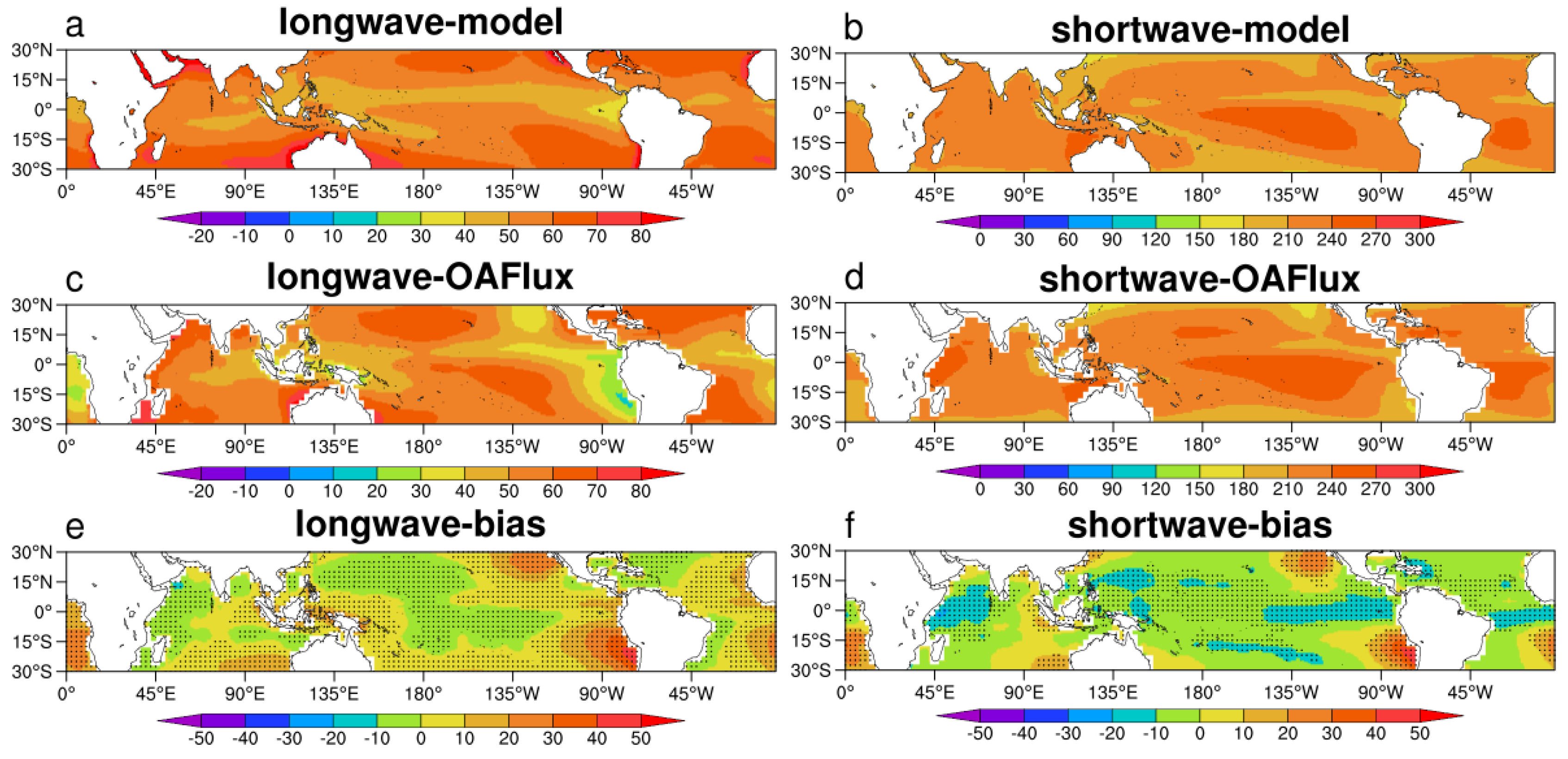
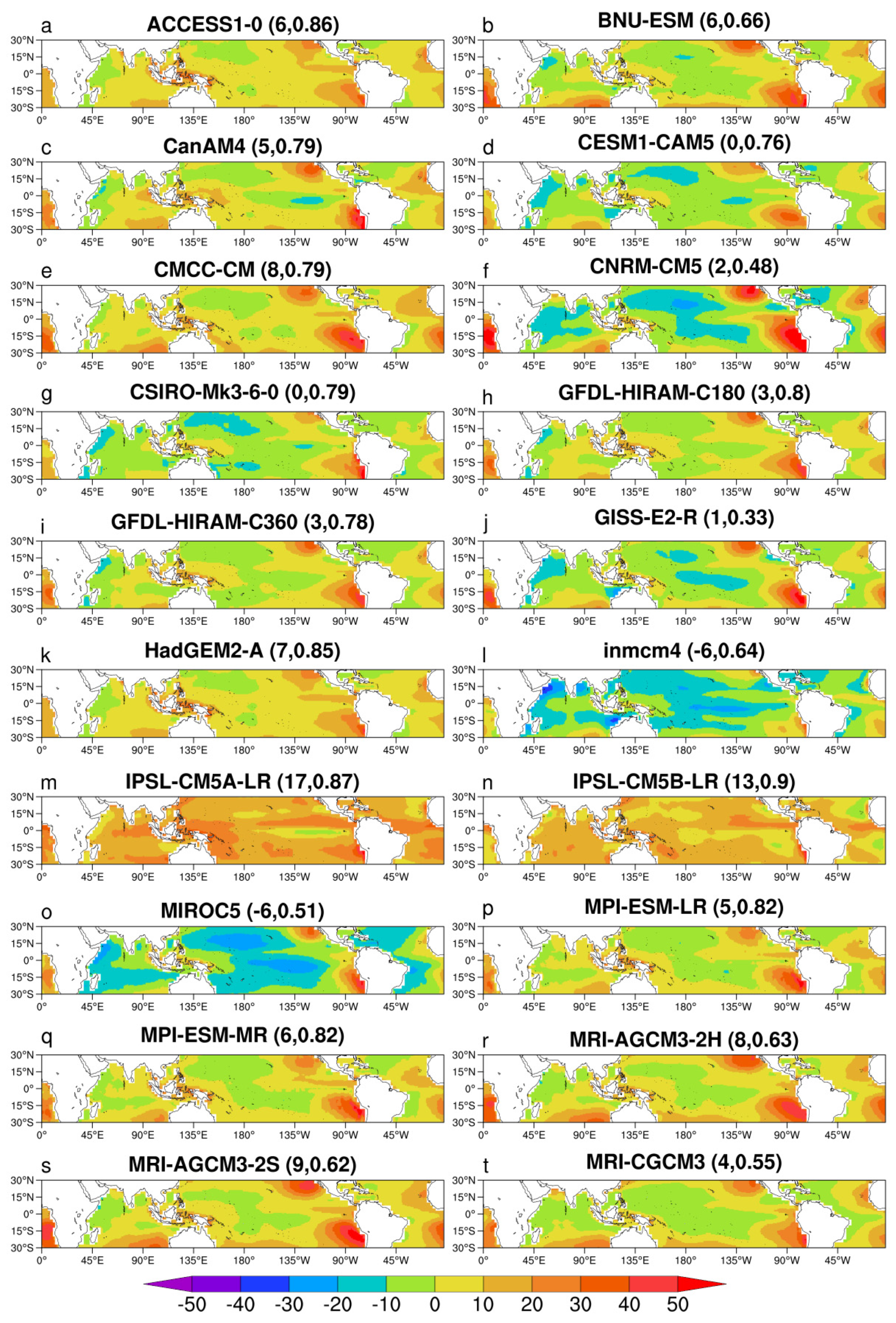
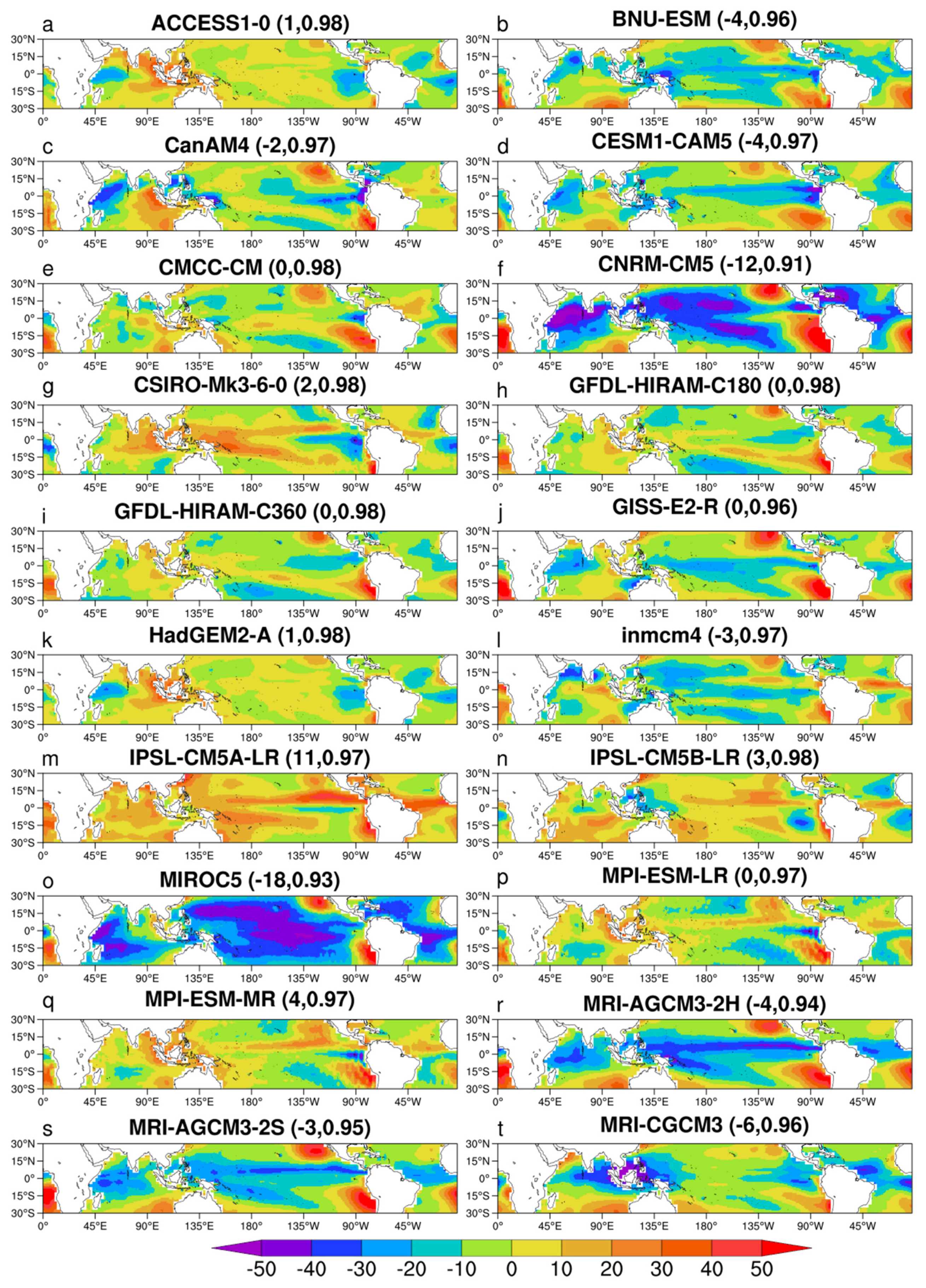
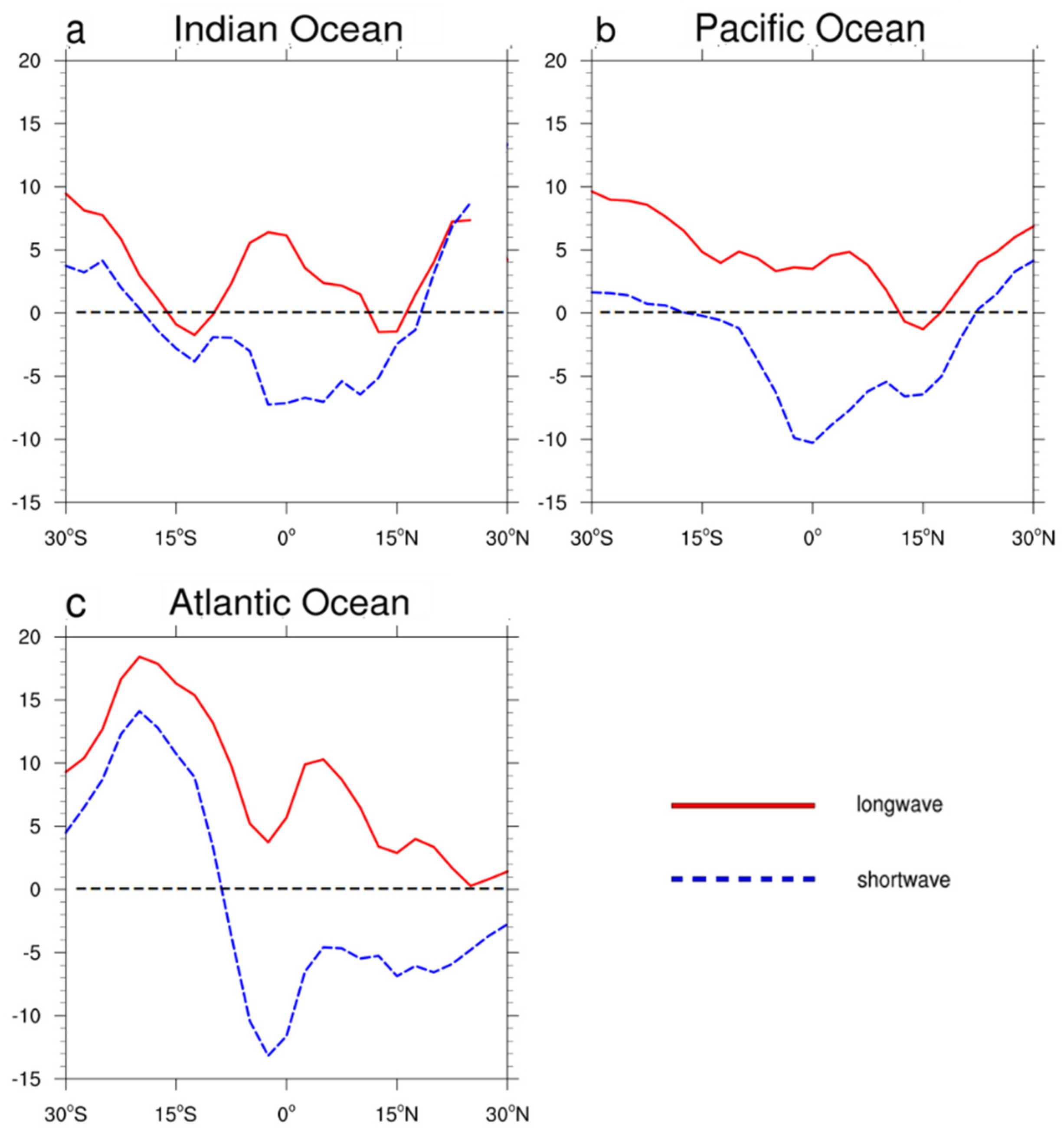
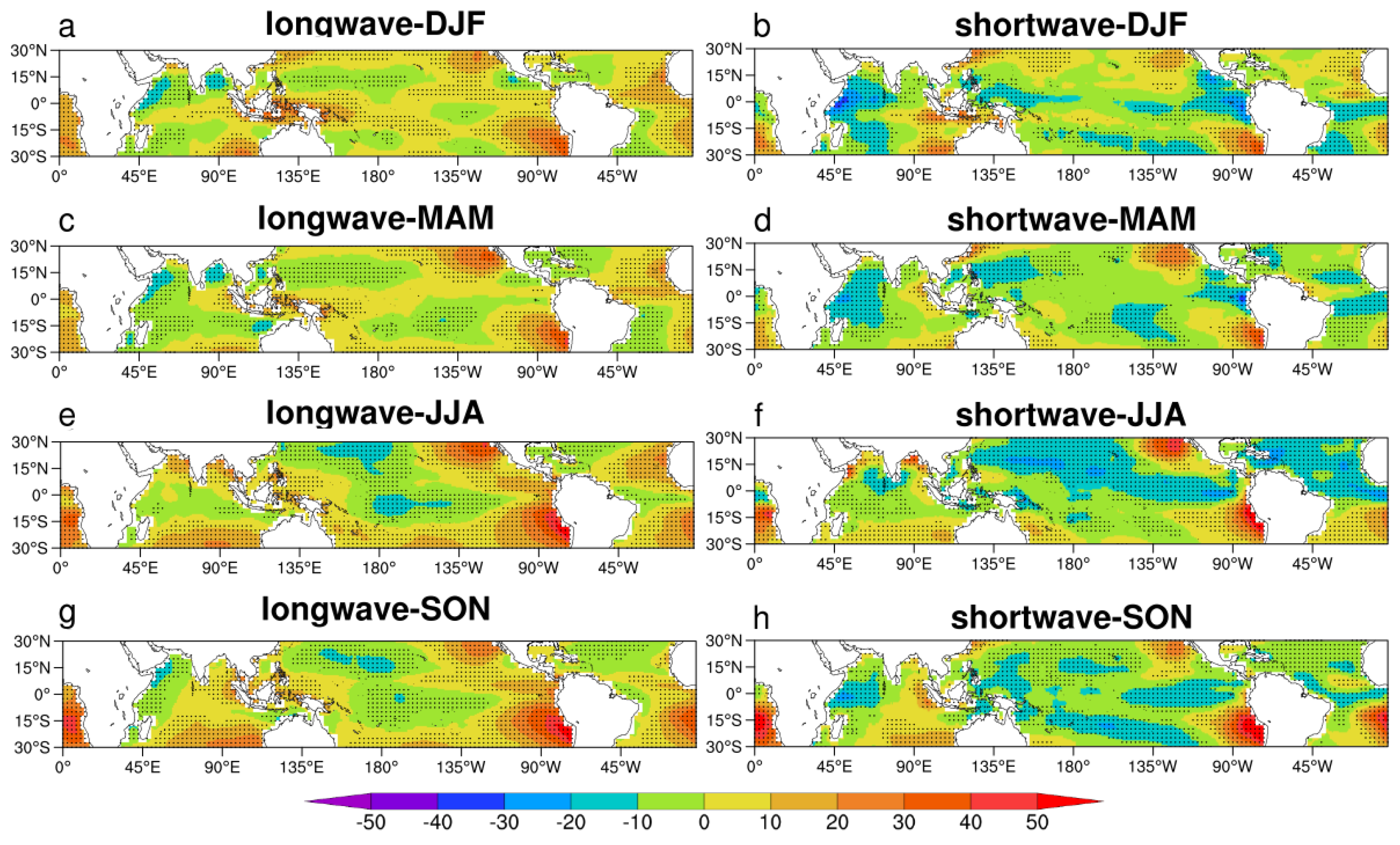
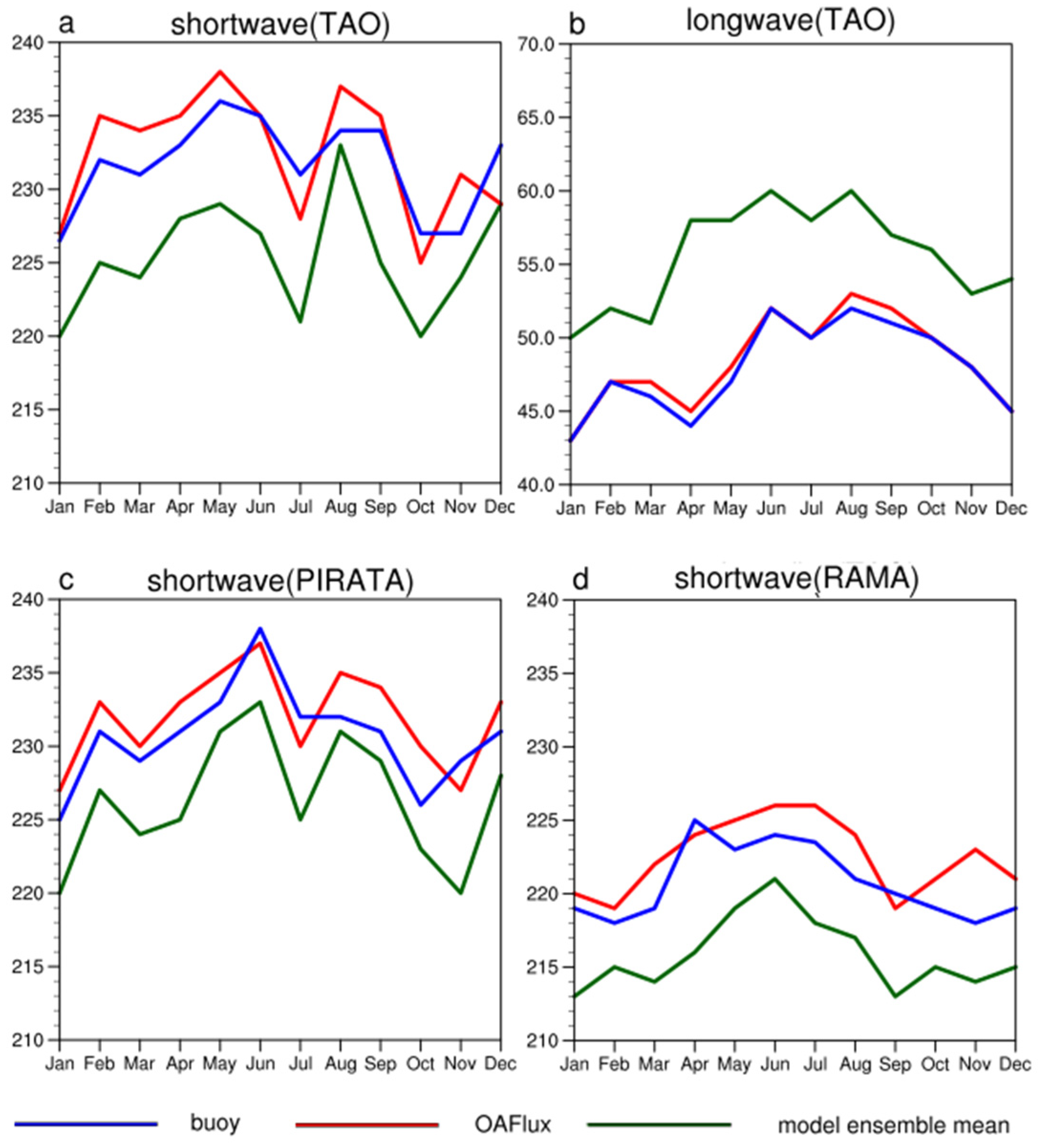
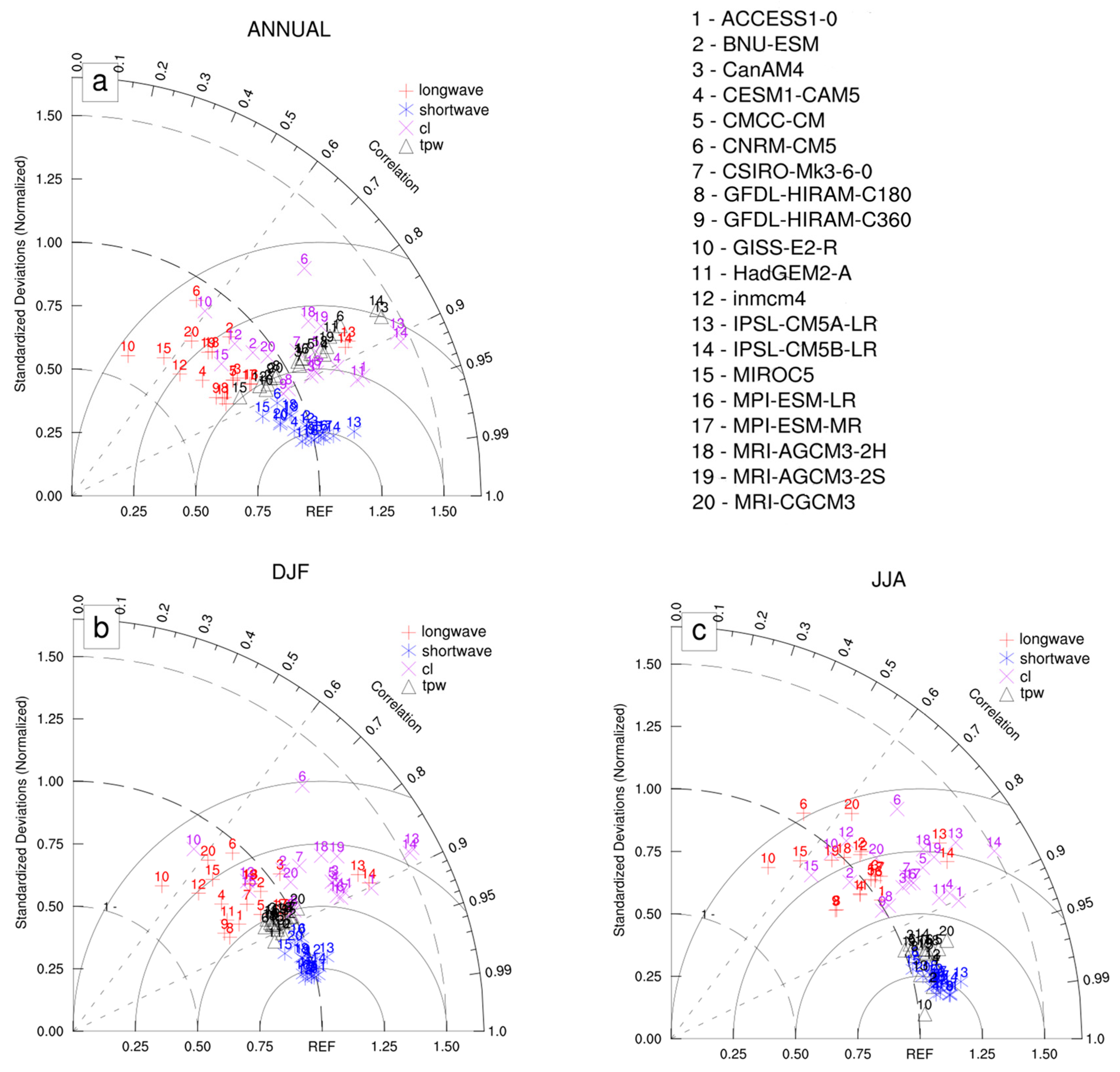
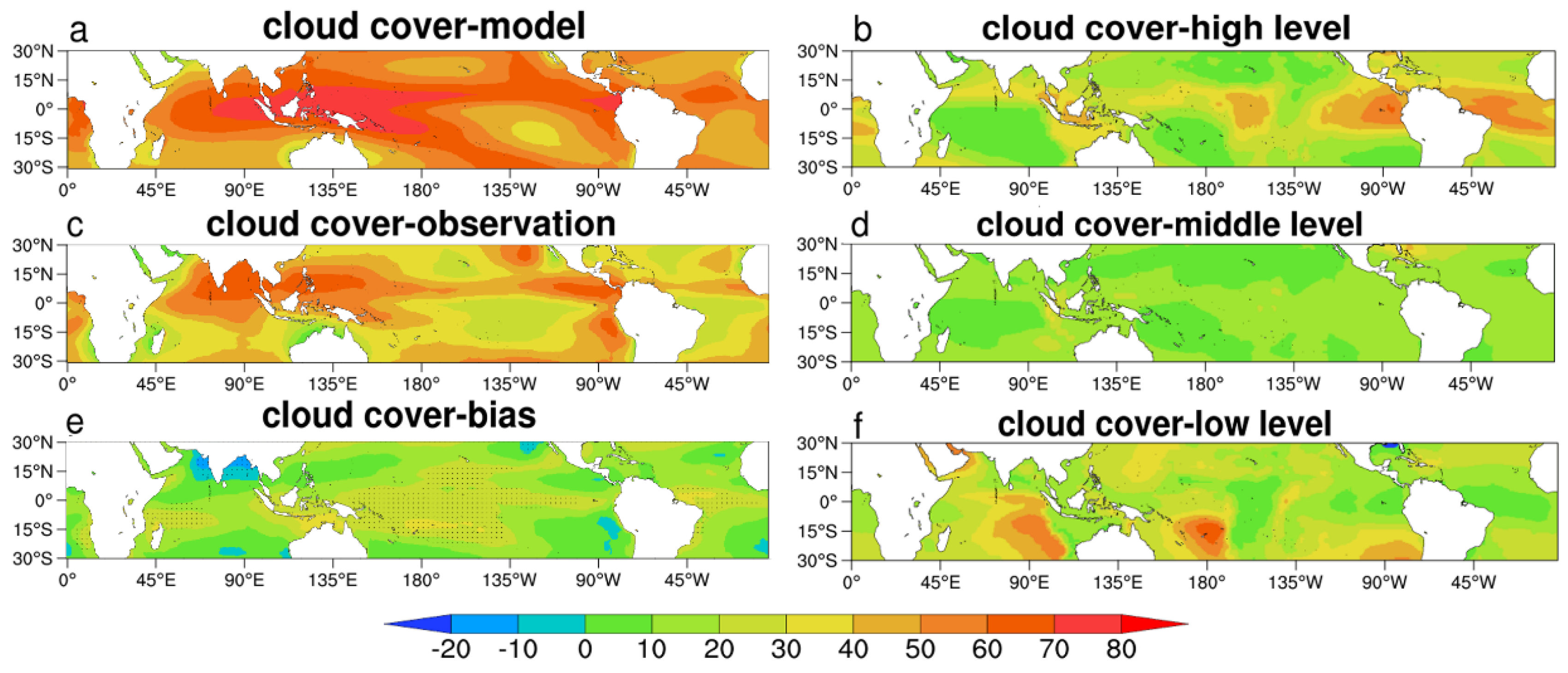
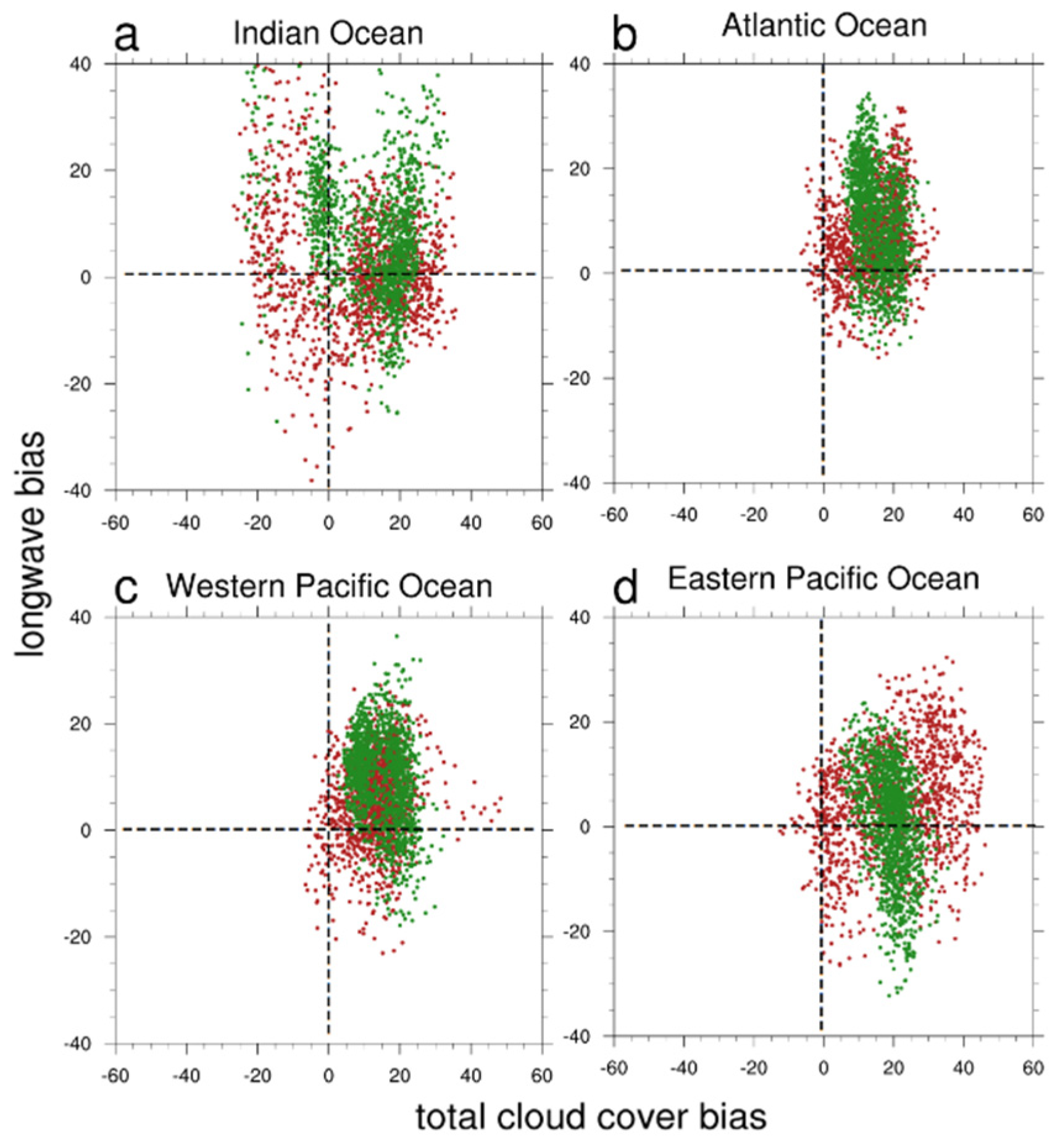
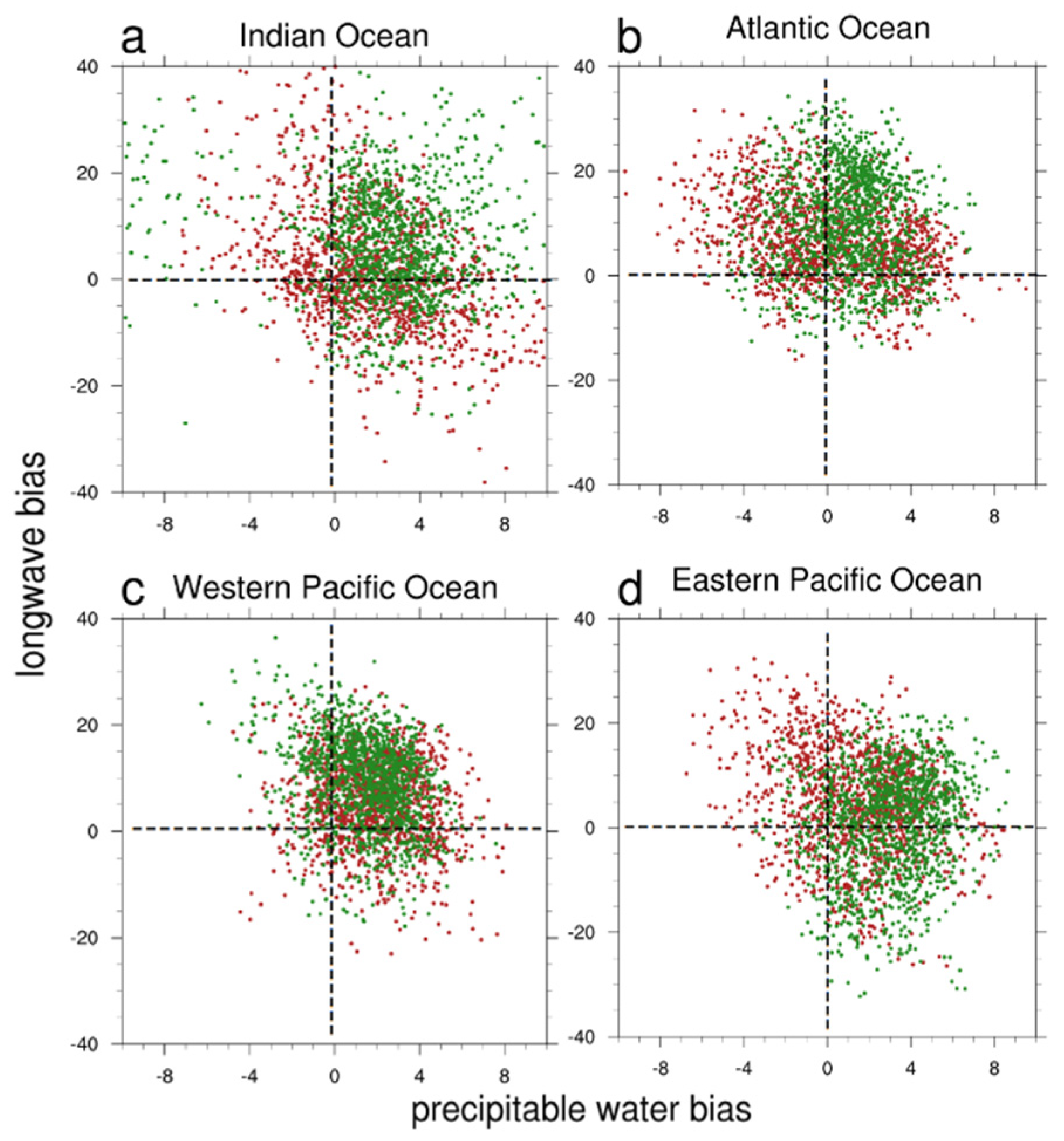
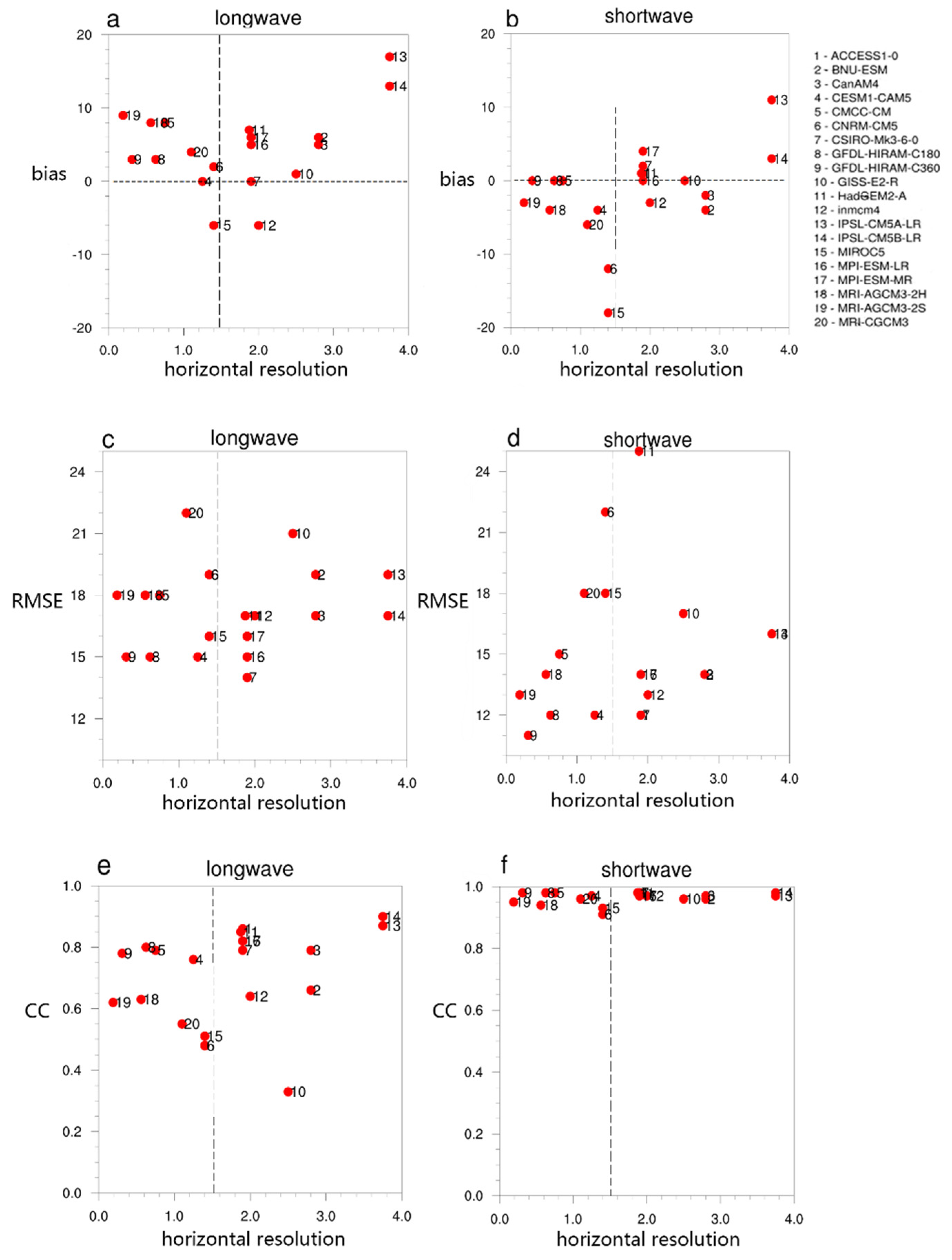
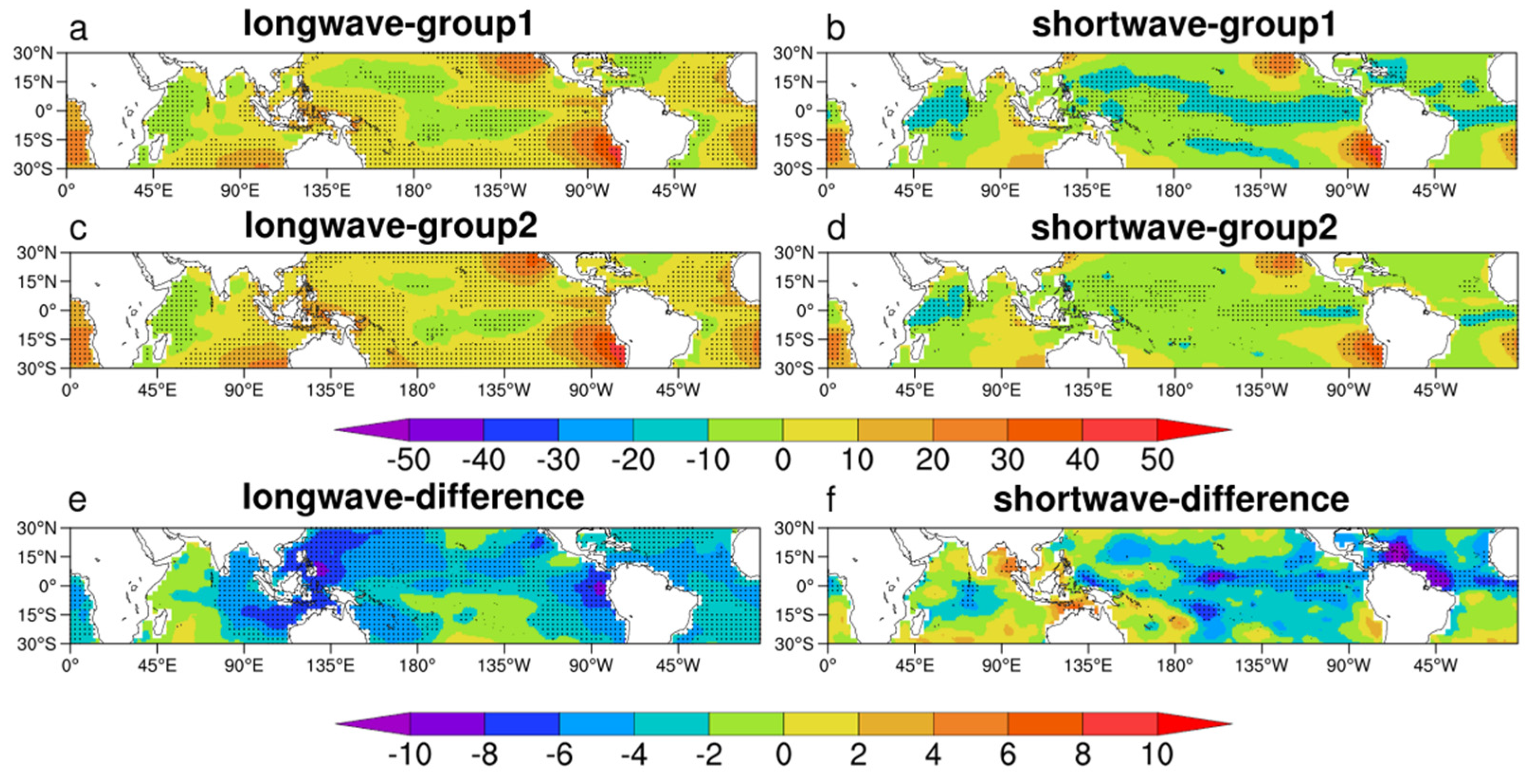
| No. | Model | Horizontal Resolution Lat × Lon (No of Levels) | References | QLW | QSW | ||||
|---|---|---|---|---|---|---|---|---|---|
| Bias | RMSE | CC | Bias | RMSE | CC | ||||
| 1 | ACCESS1-0 | 1.25° × 1.9° (38) | [22] | 6 | 16 | 0.86 | 1 | 12 | 0.98 |
| 2 | BNU-ESM | 2.8° × 2.8° (26) | [23] | 6 | 19 | 0.66 | −4 | 14 | 0.96 |
| 3 | CanAM4 | 2.8° × 2.8° (26) | [24] | 5 | 17 | 0.79 | −2 | 14 | 0.97 |
| 4 | CESM1-CAM5 | 0.94° × 1.25° (27) | [25] | 0 | 15 | 0.76 | −4 | 12 | 0.97 |
| 5 | CMCC-CM | 0.75° × 0.75° (31) | [26] | 8 | 18 | 0.79 | 0 | 15 | 0.98 |
| 6 | CNRM-CM5 | 1.4° × 1.4° (27) | [27] | 2 | 19 | 0.48 | −12 | 22 | 0.91 |
| 7 | CSIRO-Mk3-6-0 | 1.9° × 1.9° (18) | [28] | 0 | 14 | 0.79 | 2 | 12 | 0.98 |
| 8 | GFDL-HIRAM-C180 | 0.5° × 0.625° (48) | [29] | 3 | 15 | 0.80 | 0 | 12 | 0.98 |
| 9 | GFDL-HIRAM-C360 | 0.25° × 0.31° (48) | [29] | 3 | 15 | 0.78 | 0 | 11 | 0.98 |
| 10 | GISS-E2-R | 2° × 2.5° (40) | [30] | 1 | 21 | 0.33 | 0 | 17 | 0.96 |
| 11 | HadGEM2-A | 1.25° × 1.875° (60) | [31] | 7 | 17 | 0.85 | 1 | 25 | 0.98 |
| 12 | INM-CM4 | 1.5° × 2° (21) | [32] | −6 | 17 | 0.64 | −3 | 13 | 0.97 |
| 13 | IPSL-CM5A-LR | 1.875° × 3.75° (39) | [33] | 17 | 19 | 0.87 | 11 | 16 | 0.97 |
| 14 | IPSL-CM5B-LR | 1.875° × 3.75° (39) | [34] | 13 | 17 | 0.90 | 3 | 16 | 0.98 |
| 15 | MIROC5 | 1.4° × 1.4° (40) | [35] | −6 | 16 | 0.51 | −18 | 18 | 0.93 |
| 16 | MPI-ESM-LR | 1.9° × 1.9° (26) | [36] | 5 | 15 | 0.82 | 0 | 14 | 0.97 |
| 17 | MPI-ESM-MR | 1.9° × 1.9° (26) | [36] | 6 | 16 | 0.82 | 4 | 14 | 0.97 |
| 18 | MRI-AGCM3-2H | 0.56° × 0.56° (48) | [37] | 8 | 18 | 0.63 | −4 | 14 | 0.94 |
| 19 | MRI-AGCM3−2S | 0.19° × 0.19° (48) | [37] | 9 | 18 | 0.62 | −3 | 13 | 0.95 |
| 20 | MRI-CGCM3 | 1.1° × 1.1° (48) | [38] | 4 | 22 | 0.55 | −6 | 18 | 0.96 |
| Model ensemble | 4 | 16 | 0.73 | −4 | 14 | 0.97 | |||
| Seasons | DJF | MAM | JJA | SON | Annual | |||||||||||
|---|---|---|---|---|---|---|---|---|---|---|---|---|---|---|---|---|
| Qsurf | Model | Obs | Bias | Model | Obs | Bias | Model | Obs | Bias | Model | Obs | Bias | Model | Obs | Bias | |
| Comparison with OAFlux | ||||||||||||||||
| QLW | 58 | 55 | 3 | 59 | 53 | 6 | 57 | 51 | 6 | 55 | 52 | 3 | 57 | 53 | 4 | |
| (55) | (53) | (2) | (57) | (52) | (5) | (54) | (51) | (3) | (51) | (49) | (2) | (55) | (51) | (4) | ||
| QSW | 226 | 230 | −4 | 216 | 219 | −3 | 212 | 216 | −4 | 217 | 224 | −7 | 218 | 222 | −4 | |
| (226) | (235) | (−9) | (223) | (227) | (−4) | (220) | (224) | (−4) | (229) | (238) | (−9) | (225) | (231) | (−6) | ||
| Qnett | 22 | 52 | −30 | 14 | 48 | −34 | 14 | 52 | −38 | 21 | 51 | −28 | 19 | 50 | −31 | |
| (37) | (61) | (−24) | (31) | (57) | (−26) | (35) | (55) | (−20) | (50) | (72) | (−22) | (38) | (63) | (−25) | ||
| Comparison with Buoy data | ||||||||||||||||
| QLW | 54 | 53 | 1 | 57 | 54 | 3 | 56 | 52 | 4 | 57 | 52 | 5 | 56 | 53 | 3 | |
| QSW | 227 | 231 | −4 | 213 | 218 | −5 | 214 | 219 | −5 | 211 | 221 | −10 | 216 | 222 | −6 | |
| Model | QLW | QSW | ||||
|---|---|---|---|---|---|---|
| Bias | RMSE | CC | Bias | RMSE | CC | |
| Group 1 (<1.5°) | 3 (3) | 16 (13) | 0.71 (0.74) | −4 (−6) | 14 (17) | 0.96 (0.97) |
| Group 2 (>1.5°) | 5 (6) | 18 (16) | 0.73 (0.75) | 1 (−5) | 16 (21) | 0.96 (0.96) |
© 2019 by the authors. Licensee MDPI, Basel, Switzerland. This article is an open access article distributed under the terms and conditions of the Creative Commons Attribution (CC BY) license (http://creativecommons.org/licenses/by/4.0/).
Share and Cite
Zhou, X.; Ray, P.; Boykin, K.; Barrett, B.S.; Hsu, P.-C. Evaluation of Surface Radiative Fluxes over the Tropical Oceans in AMIP Simulations. Atmosphere 2019, 10, 606. https://doi.org/10.3390/atmos10100606
Zhou X, Ray P, Boykin K, Barrett BS, Hsu P-C. Evaluation of Surface Radiative Fluxes over the Tropical Oceans in AMIP Simulations. Atmosphere. 2019; 10(10):606. https://doi.org/10.3390/atmos10100606
Chicago/Turabian StyleZhou, Xin, Pallav Ray, Kristine Boykin, Bradford S. Barrett, and Pang-Chi Hsu. 2019. "Evaluation of Surface Radiative Fluxes over the Tropical Oceans in AMIP Simulations" Atmosphere 10, no. 10: 606. https://doi.org/10.3390/atmos10100606
APA StyleZhou, X., Ray, P., Boykin, K., Barrett, B. S., & Hsu, P.-C. (2019). Evaluation of Surface Radiative Fluxes over the Tropical Oceans in AMIP Simulations. Atmosphere, 10(10), 606. https://doi.org/10.3390/atmos10100606





